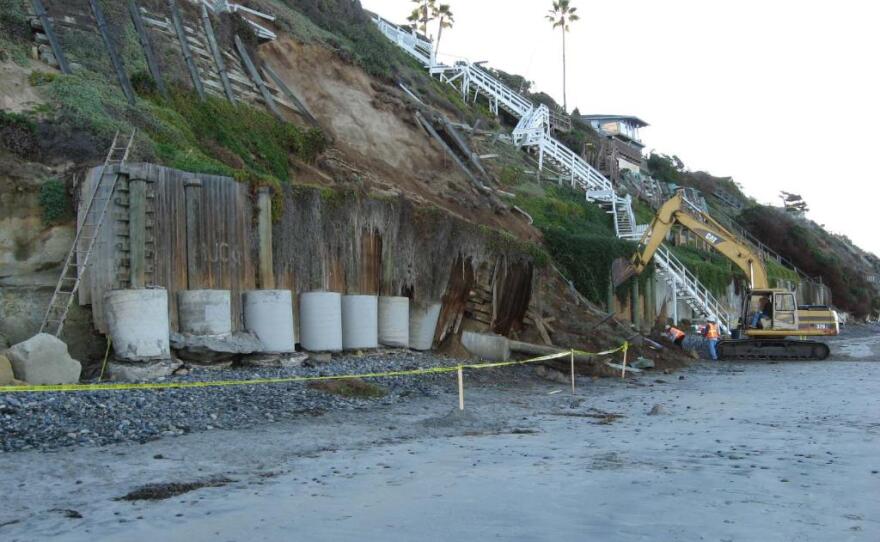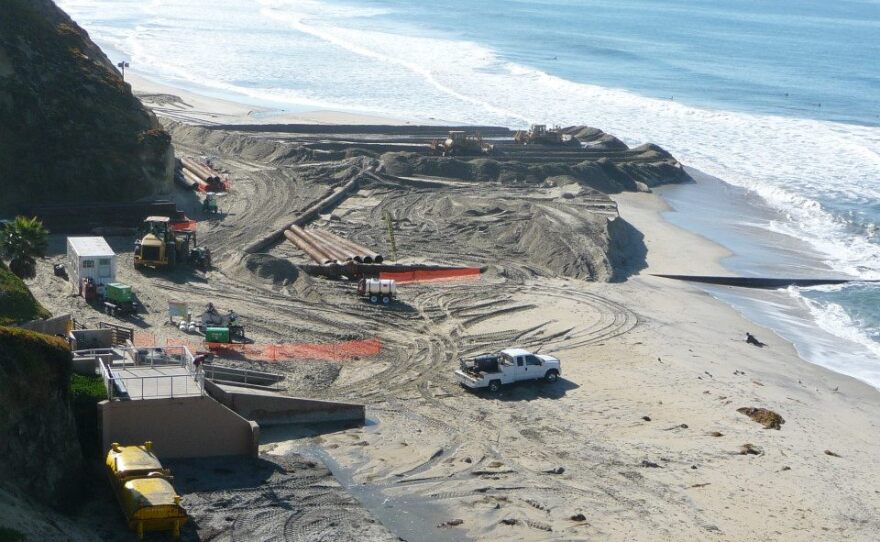At Moonlight Beach in Encinitas, resident Charlie Marvin reminisces how it was when he first came to live on the bluffs above the beach.
“When I first got here in 1971, there was a tremendous amount of sand," he said. “We used to have sand out in front of our home from May through October, where we’d set up a beach volleyball court. It was flat and heavy sand.”
Now, 10 years later, things have changed.
“In 1982 to '83“ Marvin said, “we had the El Ninos. We had two huge storms that took away a lot of the bluff.”
Beaches in North County have gotten narrower and stonier. Marvin is a strong advocate for taking action so his children and grandchildren will still have beaches to play on.
“If you don’t replenish it, you will not have beaches,” he said.
A few miles south, in Fletcher Cove, Solana Beach City Manager David Ott explains why beaches are shrinking.
“It’s because of dams up our rivers, jetties on our oceans, and parking lots that cover up the sand flows into them,” he said. “So there’s really not a natural resupply of sand. As the waves crash in, they take the sand out and eventually take all the sand out.”
Ott said future sea level rise will only add to the problem of shrinking beaches. He said Solana Beach has almost two miles of coastline — almost all of the 80-foot bluff — mostly made of rapidly eroding sandstone. Boulders the size of Volkswagens have rolled onto the beach, he said, without notice to the people below.
A large portion of the tall bluffs behind Fletcher Cove recently subsided onto the beach, and there is yellow tape fluttering in the breeze, warning people to stay clear.
“We’ve been very fortunate so far in Solana Beach that no one has died,” Ott said. “However, in Encinitas, a woman died several years ago sitting watching her husband surf.”
Private homeowners who could afford it have spent millions building seawalls to protect their properties. But Solana Beach has recently passed a new coastal land use plan that introduces a time limit on sea walls.
“They can still have seawalls,” Ott said. “But in the approved plan, the permit will be issued for 20 years, and then be re-evaluated for any changed conditions after those 20 years.”
Private property owners have sued over the 20-year time limit, which was introduced when the city worked with the California Coastal Commission to make sure its new land use plan complies with state regulations.
In the long term, the commission may adopt a more realistic approach by moving property back from the cliffs, a strategy called managed retreat. But the agency is not ruling out interim measures to protect private property, public safety and access to beaches.
Encinitas attorney Jon Corn sued the Coastal Commission and earlier this year, he won his case, defending his client’s right to replace a collapsed sea wall and stairs.

Corn said the judge called the Coastal Commission’s 20-year limit a power grab and an “unconstitutional regulatory taking” of property.
Corn believes the strategy of managed retreat needs more public input before agencies like the Coastal Commission start acting on it.
“They try to soft pedal it,“ Corn said. “‘It’s just so we can reassess it in 20 years,' but in my opinion and the judge’s opinion, that’s not the case. This is a plan to try to prevent people from having sea walls after a certain amount of time and to deploy this idea of managed retreat, which hasn’t really gone through the democratic process. “
But the City of Solana Beach negotiated long and hard with the Coastal Commission before the agency finally signed off on the city’s new land-use plan this month.
The days of shoring up the bluffs with sea walls may be numbered, in which case, plan B is to replenish the beach with millions of tons of sand. The Army Corp of Engineers will complete a study later this month on a plan more than a decade in the making to replenish beaches in Solana Beach and Encinitas throughout the next 50 years.
It would start by spreading more than 1 million cubic yards of sand between the two cities. That’s more than seven times the amount of sand that was spread in Solana Beach by a SANDAG regional project that put sand on beaches from Imperial Beach to Oceanside earlier this spring. The plan is to keep topping up the two cities with sand dredged from offshore every few years to maintain 200-foot wide sandy beaches.
Encinitas marine biologist Dennis Lees has concerns about how dredging this much sand will affect marine life.
“I’m not opposed to putting sand on the beach, “ Lees said. “My opposition relates to how much sand they are digging up offshore. They are proposing to create basins that are 20-feet deep below grade. “
Lees said he’s found shells in the sand already deposited on the beach in recent replenishment projects that show decades-old shellfish scooped up: He said the animals are an important part of the food chain.
“This guy was alive,” he said, pointing to one large shell he found on the shore. “You see how shiny he is inside, and he’s got the periostracum (a darker film covering the outside of the shell). He was alive. “
Lees said he worries that there has not been enough study into the impact that dredging would have on certain kinds of sea life just offshore.
“It’s going to take what was the best and most productive areas and turn it into dead zones for in excess of 50 years,” he said.
Approval of the sand replenishment project may be fast tracked. Ott hopes the Federal Army Corps of Engineers and the California Coastal Commission sign off on it later this summer
“There’s probably no better poster child for a sand replacement project in California than here in Solana Beach, “ Ott said. “And if we can’t be successful here, it’ll probably cause challenges for the rest of the state that may need some sand projects as well.”
Even if the sand replenishment project is approved, there is the matter of cost, which Ott estimates is about $70 million over 50 years. He said he hopes federal and state budgets will foot most of that bill.






